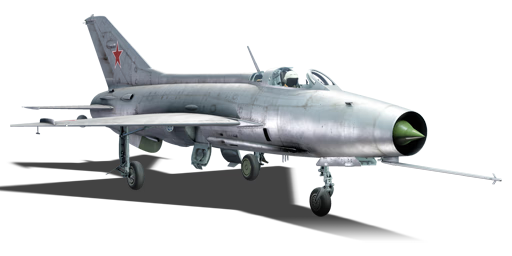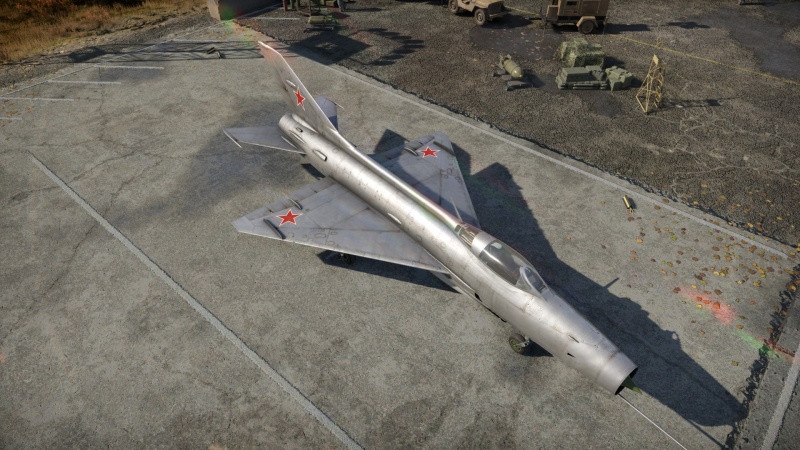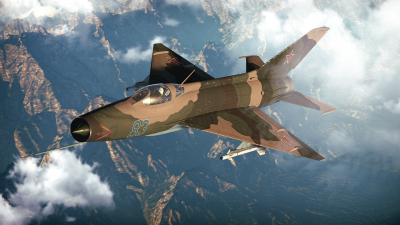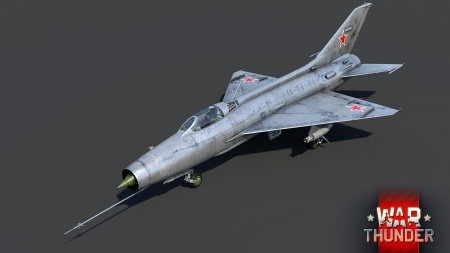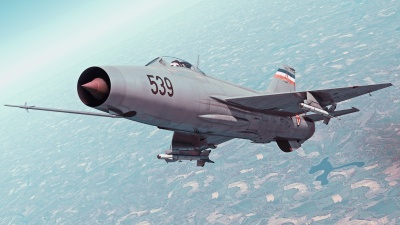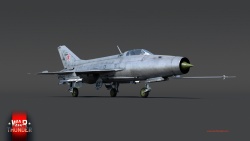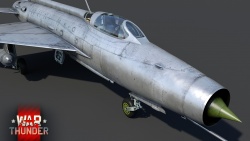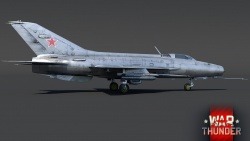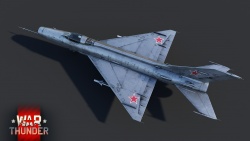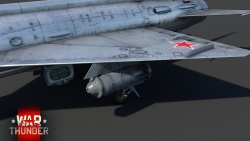Difference between revisions of "MiG-21F-13"
m (→Details: Corrected optimal velocities values) |
|||
| Line 81: | Line 81: | ||
! Ailerons !! Rudder !! Elevators !! Radiator | ! Ailerons !! Rudder !! Elevators !! Radiator | ||
|- | |- | ||
| − | | < 650 || < 600 || < | + | | < 650 || < 600 || < 900 || N/A |
|- | |- | ||
|} | |} | ||
Revision as of 12:42, 12 March 2021
| This page is about the Russian jet fighter MiG-21F-13. For other versions, see MiG-21 (Family). |
Contents
Description
The MiG-21F-13 is a rank Russian jet fighter with a battle rating of (AB), (RB), and (SB). It was introduced in Update 1.91 "Night Vision".
After the Korean War, several nations came out with various aircraft which would out-fly opposing aircraft, especially in a dogfight. The U.S. introduced the Lockheed F-104 Starfighter and Northrop F-5 Freedom Fighter while European nations France, England and Sweden rolled out the Dassault Mirage F-1, Mirage III, English Electric Lightning, Hawker Hunter and the Saab Draken. At this time the Soviet Union was working on further developing the twin-engine MiG-19 but realized what it actually needed was a fast, single-engine light-weight fighter in what ultimately became the most highly produced supersonic fighter in the world and used by over 60 countries. This fighter was the Ye-66a ('Ye' stands for "Yedinitsa" or single-unit), later changed to MiG-21 F-13 or as dubbed by NATO, the Fishbed-C. The F-13 designation identifies that this is an updated (Forsirovannyy) version which can equip the K-13 missile system capable of using the R-3S air-to-air missiles.
The MiG-21F-13 was built to be a point defence interceptor not an air-defence fighter slated for combat missions, basically a short-range day fighter. Essentially it was a missile which houses a pilot, one 30 mm cannon and two R-3S air-to-air missiles. The sleek airframe was made with aluminium alloys, steel, magnesium and fibreglass. The air-intake cone automatically adjusts during the flight to help the aircraft remain aerodynamic. The fighter sported a delta wing with a 57° leading edge and even the all-moving tailplane utilizes the swept feature. Everything about this jet focus on speed which lends it reaching out to the Mach 2 range. The strength of the aircraft is its speed in a straight line whether in a climb, level flight or a dive, however, when it turns at all, it haemorrhages its energy and when it gets below 700 km/h, it is difficult to get back up to speed without diving to make up that speed. When caught near the ground and going slow will be extremely frustrating for a MiG-21 pilot.
The MiG-21F-13 as-built shaped like a missile excels in air-to-air combat, but beware of turning or manoeuvres, though they will slow you enough to get behind an enemy fighter, it may also slow you enough for another enemy fighter to get a missile lock or gun solution on you. Always be aware of your surroundings. Though this fighter can be outfitted with rockets or bombs (250 and 500 kg), these options should be reserved for special situations as the attacker/bomber function was never designed as a multi-role function as it was with the F-4C. The R-3S missiles can be a challenge to get used to, so newer pilots may elect to outfit the S-5K rockets and use them to go after bombers or large fighters. With only 60 rounds of 30 mm cannon ammunition, trigger control is a must or else you will be waiting often for a reload timer to count down or will be frequently returning to base to reload.
General info
Flight performance
Due to the MiG-21F-13 being an interceptor fighter, its main purpose is to interdict enemy aircraft. For this purpose, a jet fighter should meet certain criteria such as being light-weight, fast, aerodynamic and cheap to build and maintain. The MiG-21F-13 fits all of these criteria to a tee. Sitting at a take-off weight of 9.5 tons and an afterburner thrust output from the R-11F-300 jet engine of 5480 kgf, the MiG was a rocket compared to other contemporary fighters/interceptor aircraft. The closest comparable aircraft in-game are the Hunter F 1, Hunter F.6 and the Super Mystere B2. Pound for pound and thrust for thrust, the Hunter F 1 is the closest with a take-off weight of 9.5 tons and power output from a Rolls-Royce Avon Mk. 113 engine with 3188.1 kgf, however, the final thrust output was no contest with the MiG-21F-13 able to fly 1,000 km/h faster than the Hunter at top speed.
Manoeuvrability in the MiG, for the most part, is non-existent. Due to the shape of the wings and the aerodynamics of the entire aircraft, it is built mostly for high-speed low-drag in a straight flight and that becomes apparent when it enters into a manoeuvre or a turn where it begins to bleed speed at a horrendous rate. With no adjustment to the throttle, a MiG-21F-13 can drop from 1,000 km/h to 600 - 700 km/h just by making a turn or manoeuvring from flying in a straight line. MiG pilots must take into account when they attempt evasive manoeuvres after a missile is fired at them as doing so they may avoid the missile, but they may also end up flying under 700 km/h which is a bad place to be and can be difficult to return from if there is no room to dive to build up speed. The best bet to use the MiG-21F-13 is up at higher altitudes where the jet flies faster and has room to dive if the speed needs to be built up after turning or manoeuvring.
While the MiG-21F-13 can be outfitted with 250 kg or 500 kg bombs, adding the extra weight impacts this fighter even more. With the bombs placed on under-wing pylons, it decreases the roll-rate of the aircraft having that weight away from the centre of the aircraft (or in comparison to a clean aircraft – without bombs). Bombs are an option for the aircraft, however, due to needing to maintain speeds above 700 km/h using the MiG as a bomber is less effective and can expose this aircraft to other fighters which prey on low and slow aircraft.
| Characteristics | Max Speed (km/h at 13,000 m) |
Max altitude (metres) |
Turn time (seconds) |
Rate of climb (metres/second) |
Take-off run (metres) | |||
|---|---|---|---|---|---|---|---|---|
| AB | RB | AB | RB | AB | RB | |||
| Stock | 2,209 | 2,194 | 34.6 | 35.2 | 98.3 | 90.7 | 750 | |
| Upgraded | 2,313 | 2,235 | 32.8 | 33.7 | 129.2 | 110.2 | ||
Details
| Features | |||||
|---|---|---|---|---|---|
| Combat flaps | Take-off flaps | Landing flaps | Air brakes | Arrestor gear | Drogue chute |
| X | ✓ | ✓ | ✓ | X | ✓ |
| Limits | ||||||
|---|---|---|---|---|---|---|
| Wings (km/h) | Gear (km/h) | Flaps (km/h) | Max Static G | |||
| Combat | Take-off | Landing | + | - | ||
| N/A | 524 | 450 | ~12 | ~6 | ||
| Optimal velocities (km/h) | |||
|---|---|---|---|
| Ailerons | Rudder | Elevators | Radiator |
| < 650 | < 600 | < 900 | N/A |
| Clean Configuration Lift Performance | |
|---|---|
| Zero-Thrust, 1G Stall speed (km/h) |
Corner speed
(km/h) |
| 210-244 | 757 |
Engine performance
| Engine | Aircraft mass | ||||||
|---|---|---|---|---|---|---|---|
| Engine name | Number | Empty mass | Wing loading (full fuel) | ||||
| Tumansky R-11F-300 | 1 | 5,110 kg | 311 kg/m2 | ||||
| Engine characteristics | Mass with fuel (no weapons load) | Max Takeoff Weight | |||||
| Weight (each) | Type | 9m fuel | 20m fuel | 30m fuel | 33m fuel | ||
| 1,120 kg | Afterburning axial-flow turbojet | 5,676 kg | 6,348 kg | 6,967 kg | 7,152 kg | 9,500 kg | |
| Maximum engine thrust @ 0 m (RB / SB) | Thrust to weight ratio @ 0 m (WEP) | ||||||
| Condition | 100% | WEP | 9m fuel | 20m fuel | 30m fuel | 33m fuel | MTOW |
| Stationary | 3,484 kgf | 5,226 kgf | 0.92 | 0.82 | 0.75 | 0.73 | 0.55 |
| Optimal | 3,484 kgf (0 km/h) |
5,226 kgf (0 km/h) |
0.92 | 0.82 | 0.75 | 0.73 | 0.55 |
Survivability and armour
- Armour
- 16 mm Steel – behind the pilot's seat
- 25 mm Steel – pilot's headrest
- 65 mm Bulletproof glass – forward canopy windscreen
With the MiG-21F-13 configured for and operated as an interceptor, not much thought was put into protecting the aircraft as it was relatively cheap and easy to build and maintain. However, protections were put in place for the pilot which on the other hand was a valuable asset. Protective steel behind the seat and pilot's headrest along with the 65 mm bulletproof glass helped protect the pilot from defensive fire coming from bomber turrets or from smaller calibre guns found on many Western fighters of the time.
The MiG-21F-13's role as an interceptor basically had it scramble from the airfield when enemy fighters/bombers entered the area and it went full afterburner to reach attack altitude where it would make several passes, down the aircraft and return to the airfield. Due to its speed and limited weapon load-out, further protections for the aircraft's critical component were not necessary and thus left off the aircraft to allow for its light-weight and quick intercept capability.
Modifications and economy
Armaments
Offensive armament
The MiG-21F-13 is armed with:
- 1 x 30 mm NR-30 cannon (60 RPG)
The MiG-21F-13 has been outfitted with a single 30 mm Nudelman-Rikhter NR-30 cannon. This gun is the perfect weapon for an interceptor class aircraft as it is large enough calibre to do some serious damage, however, this cannon only houses 60 rounds of ammunition. While the small ammunition pool appears to be a negative point to the aircraft, minimizing weight is necessary to ensure this aircraft can intercept inbound enemy aircraft. Trigger control is a necessary skill the pilot must use to ensure enough rounds available to make the necessary shots before returning to base to reload.
Suspended armament
The MiG-21F-13 can be outfitted with the following ordnance:
- Without load
- 32 x S-5K rockets
- 2 x S-24 rockets
- 2 x R-3S air-to-air missiles
- 2 x 250 kg OFAB-250-270 bombs (500 kg total)
- 2 x 500 kg FAB-500M-54 bombs (1,000 kg total)
While classed and built as a fighter-interceptor with the purpose of attacking enemy aircraft invading the homeland, the MiG-21F-13 can be outfitted with air-to-air ordnance to support this fighting tactic or it can also load up on ground-attack ordnance which can inflict some damage. Though available, this is not a strong suit for this aircraft.
- Air-to-air combat
As a true fighter-interceptor, the MiG-21F-13 in conjunction with its 30 mm NR-30 autocannon, it can also be outfitted with two additional air-to-air combat options. First is the R-3S air-to-air missiles of which only two are allocated at a time. When on the tail of an enemy aircraft there are two tones which will be emitted when attempting a missile lock, the first tone is the system searching for a target, once the target is locked onto, the tone will noticeably change. Once changed to the second tone, the missile can be fired. An enemy fighter which is paying attention to any notifications for an inbound missile does have a chance to avoid the missile, however, the longer they wait to initiate, the harder it will be for them to avoid being hit by the missile.
Secondary air-to-air armament comes in the package of 32 S-5K unguided rockets. Though less than accurate when fired off singly, salvos of these rockets will increase the chance that at least one or two rockets may hit the intended target. This ordnance is difficult to use against faster fighters, however, it may be ideal to utilise against slower bombers which may have a more difficult time out flying or outmanoeuvring these rockets.
- Ground attack combat
Though developed as a fast interceptor, the MiG-21F-13 can carry ordnance which is more specifically used for ground attack than aerial attack. Two options for rockets are available, the 32 x S-5K rockets already mentioned in the air-to-air combat section and the 2 x S-24 240 mm unguided rockets. The S-5K rockets can be used to great effect on anti-aircraft artillery, lightly armoured vehicles and aircraft landing, taking-off or parked on runways waiting for repairs or reloading. Since the S-5K is unguided and therefore not highly accurate, especially being launched from the MiG-21F-13 and low altitudes, it is best to launch large salvos at the intended targets to increase the chances a hit is made. The S-24 rocket is just over two metres long and therefore only two can be outfitted on the aircraft. This rocket has its similarities to the U.S. unguided rocket the Tiny Tim. These larger rockets pack a punch and can be used for enemies on the ground clustered together, harder targets such as medium and heavy tanks, reinforced pillboxes and can even whittle away at the enemy bases.
A final ground attack option is to outfit bombs to the aircraft in either total weight of 500 kg or 1,000 kg. Either 250 kg or 500 kg bombs can be mounted to underwing pylons to be used on ground targets, however, while these are attached to the aircraft, its overall speed and manoeuvrability will suffer. Bombing with the MiG-21F-13 can be a bit of a challenge without a bombsight or trying to hit a target while in a dive. Attempting a horizontal attack reduces the overall speed of the aircraft and makes it an easier target for enemy fighters waiting to pounce.
Usage in battles
The MiG-21F-13 was designed to be a fighter-interceptor and thus all of its design features shape it into virtually a missile with a cockpit. This aircraft wasn't designed to carry the load the F-4C, G.91 YS or the Super Mystere B2, but it was built for speed and to bring along the minimal amount of armament to do its job.
As a fighter-interceptor, the MiG-21F-13 needed to get from Point A (the airbase) to Point B (the inbound enemy aircraft) in the shortest amount of time possible, shoot it and return to base to get ready for the next one. This jet can remain fast if it is flying in a straight line, however do not try to sustain dogfights in it. Despite this MiG receiving a new FM update on the 7th of Nov. 2019 (weight reduction, aerodynamics and climb rate improved), it still has a high AoA, meaning it bleeds a good amount of speed in hard turns.
The best use of this aircraft is to utilise its excellent speed and rate of climb and gain altitude and begin to level off when you are either at bomber altitude or just above any enemy fighters flying around. It is here you can use the great Boom & Zoom qualities of the aircraft and select a target and begin to dive on it. It is during this phase when you can attempt to get a lock with the R-3S air-to-air missiles and launch it or you can strafe any unwary targets with the 30 mm NR-30 autocannon. Extremely short bursts are a must in order to conserve ammunition (only 60 rounds total), but this powerful gun only needs one or two good shots to remove a wing, take out a pilot or disable an engine. Once shots have been taken, regardless if they hit or missed, engage the afterburner and return to higher altitudes and set up for another Boom & Zoom run. Boom & Run techniques also work in that you can use the phenomenal speed of the MiG-21F-13 to outrun just about any aircraft on the map (however beware of the F-4C which can keep pace if not outrun the MiG-21F-13).
Options are available to use this aircraft in the role of ground-attack, however, this may be an extreme challenge, especially to any novice fighter jet pilots. While the 30 mm autocannon is standard in all of the ordnance load-outs, when adding a secondary suspended armament, you are limited to only one type. In this case, you will need to choose from 32 light-weight S-5K rockets, two S-24 rockets, two 250 kg bombs or two 500 kg bombs. The added weight and loss of aerodynamics when adding any of this ordnance can be difficult to overcome, especially since this aircraft is built for speed over manoeuvrability.
When attacking ground targets, it is best to place the MiG-21F-13 into a relatively shallow dive, it is important to remember to properly line up for the target ahead of time because with the external ordnance fine-tune manoeuvring can be difficult especially when corrections need to be made at the last minute. Lack of a bombsight makes bombing smaller targets a bit more difficult to hit. When flying low to take on ground targets, make sure you leave yourself an out when the situation turns bad. The best practice here is to ensure you keep your speed up, slow enough to hit the target, but fast enough to get away when the situation turns.
Pros and cons
Pros:
- Great top speed (true interceptor)
- Moderately high acceleration
- Has access to air-to-air missiles (R-3S)
- Hard-hitting and accurate 30 mm cannon, quick bursts make 60 rounds last long and are enough for kills
- Great manoeuvrability at high speeds, can sustain 11G - 12G even at 1,200 km/h IAS (can also pull 13G for a second), best-used with Boom & Zoom tactics
- Fairly small target
- Multiple choices for suspended armaments depending on the map being played
- Very good roll rate at all speeds
- Has access to one of the largest rockets with a timed fuse, the S-24 which may be used against aircraft.
- Does not spin easily in a positive G-load stall
- Rapid energy bleeding can allow you to go from Mach 1 to landing speeds in a single hard 90 degree turn with trimming controls, allowing for rapid base return and landings
- Can perform a Cobra manoeuvre with full real controls
Cons:
- Only one gun with 60 rounds of ammunition can prove to be difficult for newcomers, a minuscule 3.6 seconds total firing time (compared to 24 seconds of the 3x gunpod loadout of the F4 Phantom)
- Quirky rudder characteristics on mouse aim
- Missiles have a short lock-on range and are unreliable due to firing orientation requirements for a consistent hit
- Mediocre when used against ground targets and as an air defence interceptor
- Single cannon (no back-up during jams)
- Single type suspended armament, no multi-role options such as missiles + bombs or rockets + bombs
- Stable unstalled inverted spin with awkward recovery technique for joystick pilots
- Abnormally strong up-righting torque (for a jet) can be annoying when aiming
- Negative pitch stability above 500 km/h
- Deep-stalled flat-spinning MiG-21s cannot recover from spin
- Wing overloads cause the MiG-21F-13 to be incapable of reaching its acclaimed top speed unless airframe modification is unlocked
History
The MiG-21 series of planes would become the most widely-used family of fighter jets in the world, with over 4,000 produced, including license-built copies in China, India and Czechoslovakia. The roots of this highly successful combat aircraft started in the mid-1950s, with the Soviet desire to create a Mach-2 capable light fighter. The first MiG-21F prototypes were presented at the Tushino air show in June 1956, and deliveries started in 1958. The model, "Fishbed C" in NATO parlance, was widely exported. In the Soviet Union, it was replaced by the MiG-21PF model after 1961.
Devblog
Development of the MiG-21 dates back to the early 1950s, when the Mikoyan design bureau was conducting development work on a design study for a new swept-wing jet aircraft. Further work on the project led to the creation of a seperate, delta wing prototype, designated 'Ye-4'. With test flights showing promising results, but also much room for improvement, work on the Ye-4 resumed. Further tweaks and modifications to the design eventually lead to the Ye-5 prototype, which conducted its maiden flight in January 1956.
During testing, the Ye-5 received its new designation 'MiG-21' and was officially ordered into production. However, production of this initial batch of MiG-21s was rather short, with only a handful of machines being built. In the meantime, an improved version of the aircraft - the Ye-6 - was being worked on. By May 1958, testing of the Ye-6 was deemed to be completed. Shortly afterwards, in July, the Ye-6 was ordered into mass production under the designation MiG-21F and was to replace the initial MiG-21 as the standard production model. The aircraft weaponry consists of two 30 mm automatic cannons. The next step was to equip the aircraft with guided "air-to-air" missiles but in to do this one of the cannons had to be removed.
From there on, the MiG-21 would go on to be produced in enormous numbers and in various different variants, both for the needs of the Soviet Union, as well as for export. Around 60 countries have or still use the MiG-21 in various capacities and modifications today.
Well over 11,000 MiG-21s have been produced, including licence-built versions (more than 2,400 models were built in China under the J-7 designation), since the start of production in 1959, with the legendary 'Fishbed' becoming the most mass produced combat aircraft since the Korean War and taking part in more armed conflicts than a single devblog would ever be able to cover. But as an example we can mention its participation in the Vietnam War where the MiG-21 was able to push back against the latest U.S. aircraft (which were in majority).
Media
- Images
- Videos
See also
- Related development
External links
- [Development] MiG-21F-13: The Silver Swallow
- Official data sheet - more details about the performance
- militaryfactory.com website - Mikoyan-Gurevich MiG-21 (Fishbed)
- historynet.com website - The Iconic MiG-21 "Fishbed"
- nationalinterest.org website - Russia's MiG-21 Fighter Could Keep Flying and Fighting for 100 Years
- Bridgewater, S., & Gibbs, R. (Eds.). (2019). MiG's Fabulous Fishbed. MiG - Red Star Fighters, 52–61. ISBN 9781912205127
| Mikoyan-Gurevich Design Bureau (Микоя́н и Гуре́вич Опытное конструкторское бюро) | |
|---|---|
| Fighters | MiG-3-15 · MiG-3-15 (BK) · MiG-3-34 |
| I-225 | |
| Jet fighters | MiG-9 · MiG-9 (l) |
| MiG-15 · MiG-15bis · MiG-15bis ISh | |
| MiG-17 | |
| MiG-19PT | |
| MiG-21F-13 · MiG-21PFM · MiG-21S (R-13-300) · MiG-21SMT · MiG-21bis | |
| MiG-23M · MiG-23ML · MiG-23MLD | |
| MiG-27M · MiG-27K | |
| MiG-29 · MiG-29SMT | |
| Export/Licensed | ␗MiG-9 · ␗MiG-9 (l) |
| ◊MiG-15bis · ◔MiG-15bis · J-2* | |
| MiG-17AS · ◔MiG-17PF · J-4* · Shenyang F-5* | |
| ◊MiG-19S · J-6A* | |
| ◄MiG-21 SPS-K · ◊MiG-21MF · ◔MiG-21MF · ▄MiG-21bis · ◔MiG-21bis-SAU · ◊MiG-21bis-SAU · ◊MiG-21 "Lazur-M" · ▄MiG-21 Bison · J-7II** | |
| ◊MiG-23BN · ◊MiG-23MF · ◔MiG-23MF · ◊MiG-23MLA | |
| ◔MiG-29 · ◊MiG-29 · ◄MiG-29G | |
| *Licensed and domesticated with Chinese designations. | |
| **Unlicensed, reverse-engineered and domesticated with Chinese designations. | |
| See Also | Shenyang · Chengdu |
| USSR jet aircraft | |
|---|---|
| Bereznyak-Isayev | BI |
| Yakovlev | Yak-15 · Yak-15P · Yak-17 · Yak-23 · Yak-28B · Yak-30D · Yak-38 · Yak-38M · Yak-141 |
| Mikoyan-Gurevich | MiG-9 · MiG-9 (l) · MiG-15 · MiG-15bis · MiG-15bis ISh · MiG-17 · MiG-17AS · MiG-19PT |
| MiG-21F-13 · MiG-21PFM · MiG-21S (R-13-300) · MiG-21SMT · MiG-21bis | |
| MiG-23M · MiG-23ML · MiG-23MLD · MiG-27M · MiG-27K | |
| MiG-29 · MiG-29SMT | |
| Lavochkin | La-174 · La-15 · La-200 |
| Sukhoi | Su-9 · Su-11 |
| Su-7B · Su-7BKL · Su-7BMK · Su-17M2 · Su-17M4 · Su-22M3 | |
| Su-24M | |
| Su-25 · Su-25BM · Su-25K · Su-25T · Su-25SM3 · Su-39 | |
| Su-27 · Su-27SM | |
| Su-34 | |
| Ilyushin | IL-28 · IL-28Sh |
| Tupolev | Tu-14T |


